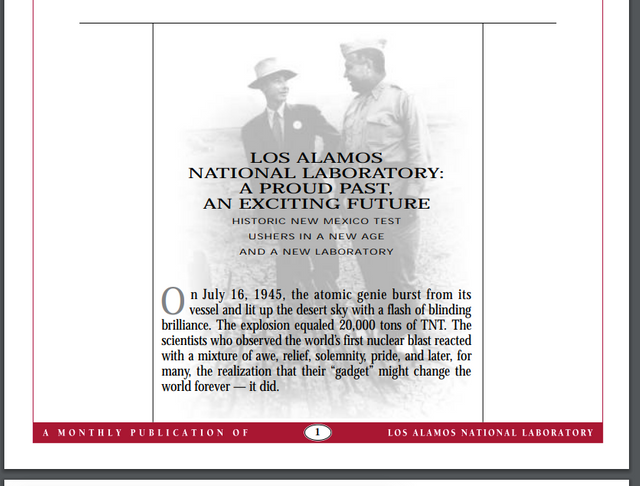
According to Wired in 2003
Despite the nation's heightened terror alert status, despite looming congressional hearings into the lab's mismanagement and slack-jawed security, an untrained person -- armed with only the vaguest sense of the facility's layout and slowed by a torn Achilles tendon -- was able to repeatedly gain access to the birthplace of the atom bomb.
"While Los Alamos is praised as a jewel of homeland security, it may actually be one of the country's biggest vulnerabilities," said Danielle Brian, executive director of the Project on Government Oversight, a watchdog organization that's eyed Los Alamos for years.
Founded in World War II by a tiny group of scientists and military personnel racing to develop atomic weapons, the lab now has over 12,000 employees spread across 2,224 buildings on 43 square miles.
These people are involved in a staggering array of endeavors: nuclear bomb design and maintenance, climate studies, supercomputer development, advanced spy-sensor research and more. Managed by the University of California for the Department of Energy, the lab is responsible for six major nuclear weapons systems, including the Minuteman III intercontinental ballistic missiles.
Pulling a rented car onto the road's red gravel shoulder, I stepped over one of the string borders. Then I walked parallel to Route 4 for a few hundred feet until I hit a chain-link fence.
I had come to the perimeter of Technical Area 33, one of the facilities Ambrosiano said was "secure." Officially, TA-33 is described only as a "former explosives testing area." According to lab sources, however, TA-33's collection of prefabricated shacks and converted trailers is one of Los Alamos' most secret sections, focused in part on "black," or covert, operations. Nine tons of uranium-contaminated soil was removed from the area in 1999.
Imagine my wide-eyed surprise when I saw that the fence surrounding TA-33 ended only a few dozen yards from the road. Heart pounding, I stepped around the perimeter. Stopping at a decrepit barbed-wire fence outlining TA-33's rear, I swung my legs over, one at a time.
And I was in.
I could see a police-style vehicle with at least one guard in it just a few hundred feet away. But the car's occupants were oblivious to my presence. I strolled up to a silver building. Its windows were open.
TA-33, isolated on the lab's southern extremity, has become the epicenter of controversy in recent months. According to a search warrant filed by the FBI, it was here that maintenance managers Peter Bussolini and Scott Alexander allegedly stored tens of thousands of dollars' worth of camping gear and consumer electronics they fraudulently charged to lab accounts.
Around facilities like the biology lab, where anthrax and other biotoxins have been handled, no sentries stand guard at all. Nor is there any kind of fence to keep the curious and the malicious away -- not even a piece of string.
Lets not forget what happened while Bill Richardson was Governor.
Bill Richardson
30th governor of New Mexico from 2003 to 2011.
He was U.S. Ambassador to the United Nations and Energy Secretary in the Clinton administration
also served as a U.S. Congressman, chairman of the 2004 Democratic National Convention, and chairman of the Democratic Governors Association.
In December 2008, he was nominated for the cabinet-level position of Secretary of Commerce in the first Obama administration, but withdrew a month later as he was investigated for possible improper business dealings in New Mexico.
Nuclear Secrets to China?
His tenure at the Department of Energy was marred by the Wen Ho Lee nuclear controversy. As told by The New York Times in a special report, a scientist later named as Dr. Lee at the Los Alamos National Laboratory was reported as a suspect who might have given nuclear secrets to the Chinese government. The article mentioned Richardson several times, although he denied in sworn testimony that he was the source or that he made improper disclosures. After being fired and spending nine months in solitary confinement as an alleged security risk, Dr. Lee was later cleared of espionage charges and released with an apology from the judge. Eventually Dr. Lee won a $1.6 million settlement against the federal government and several news outlets including the Times and The Washington Post for the accusation.
Richardson was also criticized by the Senate for his handling of the espionage inquiry, which involved missing computer hard drives containing sensitive data, and for not testifying in front of Congress sooner. Richardson justified his response by saying that he was waiting to uncover more information before speaking to Congress. Republican Senators called for Richardson's resignation while both parties criticized his role in the incident, and the scandal ended Richardson's hope of being named as Al Gore's running mate for the 2000 presidential election.
Richardson Integral in the creation of NNSA (National Nuclear Security Administration) which was the forerunner of DHS.
Richardson tightened security following the scandal, leading to the creation of the National Nuclear Security Administration.
This foreshadowed the creation of the Department of Homeland Security in reaction to the 9/11 attacks. Richardson also became the first Energy Secretary to implement a plan to dispose of nuclear waste.
Somebody Sure liked Richardson
In 2000, Bill Richardson was awarded a United States Institute of Peace Senior Fellowship. He spent the next year researching and writing on the negotiations with North Korea and the energy dimensions of U.S. relations. In 2011, Richardson was named a senior fellow at the Baker Institute of Rice University.
Richardson also joined Kissinger McLarty Associates, a "strategic advisory firm" headed by former Secretary of State Henry Kissinger and former Clinton White House chief of staff Mack McLarty, as Senior Managing Director.[33] From February 2001 to June 2002, he served on the board of directors of Peregrine Systems, Inc.
He also served on the corporate boards of several energy companies, including Valero Energy Corporation and Diamond Offshore Drilling. He withdrew from these boards after being nominated by the Democratic Party for governor of New Mexico, but retained considerable stock holdings in Valero and Diamond Offshore.
Seems like Lots of conflict of interests with Many in government when you start looking at their history!
He would later sell these stocks during his campaign for President in 2007, saying he was "getting questions" about the propriety of these holdings, especially given his past as energy secretary, and that it had become a distraction.
At the request of the White House, he also flew to North Korea in 2005, and met with another North Korean delegation in 2006. On December 7, 2006, Richardson was named as the Special Envoy for Hemispheric Affairs for the Secretary General of the Organization of American States with the mandate to "promote dialogue on issues of importance to the region, such as immigration and free trade".

Collaboration with Richard Branson (connected to NEXIVM and buddy, island hopper neighbor to Epstein)
Was found to be useful for the NEXIVM gang in trying to find new converts while discussing slave strategies at their "We're bored passed off as "Destination Board Meetings!"
If you're not familiar see more info in sources.
In December 2005, Richardson announced the intention of New Mexico to collaborate with billionaire Richard Branson to
bring space tourism to the proposed Spaceport America located near Las Cruces, New Mexico.
With Eric Schmidt on visit to North Korea
In January 2013, he led a delegation of business leaders, including Google chairman Eric Schmidt, shortly after the state had launched an orbital rocket.
In closing on Richardson, I just want us all to remember where Isaac Kappy was born and raised. In Albuquerque, New Mexico. A beautiful city with spectacular mountains (Sandia Mountains), but many secrets have been kept to to the Sandia National Laboratory.
According to CDC dot gov,
The U.S. Department of Energy owns the Los Alamos National Laboratory (LANL) in northern New
Mexico. LANL is also referred to as the “Lab” in this document. The University of California has
managed the laboratory since its establishment in 1943 as part of the Manhattan Project to create the
first atomic weapons. The facility name was Los Alamos Scientific Laboratory until 1981. LANL’s
responsibilities have expanded since then to include thermonuclear weapons design, high explosives
and ordnance development and testing, weapons safety, nuclear reactor research, waste disposal,
waste incineration, chemistry, criticality experimentation, tritium handling, biophysics, and
radiobiology.
After World War II, LANL’s primary mission has been to serve as an experimental facility for defense
related programs and for basic scientific research and development (R&D). While at times LANL has
provided production capacity as a backup to other U.S. nuclear weapon sites, its primary R&D
mission has largely continued uninterrupted throughout the lab’s history and to the present day. The
development of these LANL Technical Basis Documents (TBDs) is particularly challenging due to the
wide range of research and development activities and intermittent involvement in the production and
testing of nuclear weapons. The challenge in developing the LANL TBDs is, in part, to account for the
many changes that have occurred over the lab’s history with regards to radioactive sources of
occupational exposures and the facilities and processes within which these sources were present.
The diversity of lab operations may be second-to-none when compared to other sites within the DOE
complex. With a few exceptions, most man-made or natural radionuclides known to exist have, at one
time or another, been present and/or processed at LANL. Many of these have been handled in small
quantities for research and development while others were experimented with and processed on
much larger scales (e.g., plutonium isotopes). This document attempts to highlight those radioactive
materials or radiation sources that can be tied to particular operations and have been well
documented over time. As new information becomes available or as claimant information
requirements change or expand over time, descriptions of other sources of radiation at LANL
will be added to this document in future revisions.
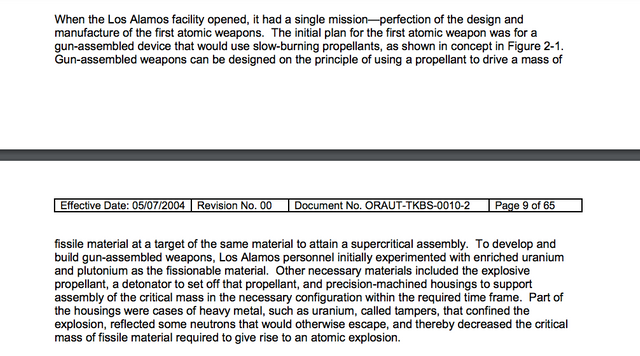
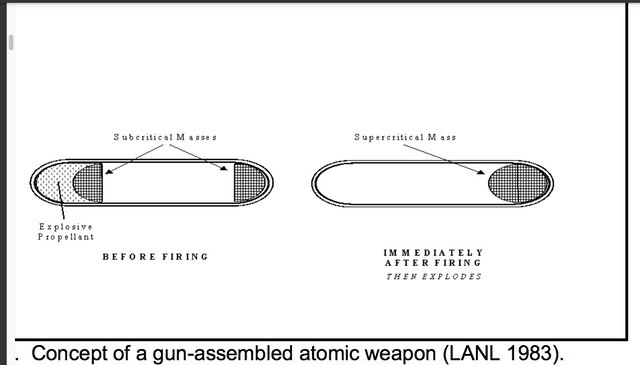
Early development work centered on use of 235U or 239Pu in gun-assembled devices. Top priority was
given to development of a plutonium-projectile gun device, which posed more problems than the
uranium design due to tighter purity specifications and the need for a faster assembly velocity. In July
1944, it was found that the plutonium received at Los Alamos would not work in gun-assembled
weapons because of the presence of more of the 240Pu isotope than expected amidst the desired
239Pu. The spontaneous neutron emission rate from that 240Pu was several hundred times greater
than allowable. As a result, while research on the certain-to-work enriched uranium gun-assembled
weapon continued, development of a plutonium device shifted to an implosion-assembled design.
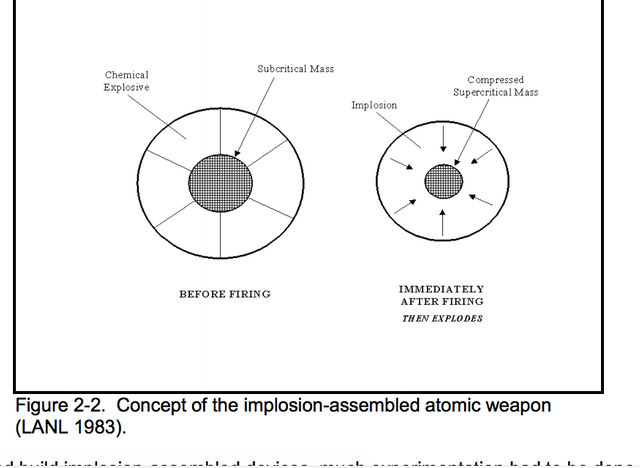
To develop and build implosion-assembled devices, much experimentation had to be done with
chemical high explosives to achieve precise assembly of something with great symmetry, in contrast
to the typical destructive use of explosives. In addition to fissionable material, high explosives,
detonators, and tamper material, work on implosion-assembled devices included development of
initiators that acted as strong sources of neutrons at the precise time that the supercritical masses
came into position. These initiators used materials including 226Ra, 210Po, and beryllium.
With the successful demonstration of fission devices, scientists were able to achieve the high
temperatures necessary to bring about fusion of hydrogen nuclei for use in the superbomb that had
been studied for years as a theoretical possibility. Viewed by some as Los Alamos’ second historic
mission, development of thermonuclear or hydrogen devices led to the first full-scale testing in the
Mike shot in the Pacific in late 1952. Thermonuclear devices rely on a two-stage process, in which
energy from a fission primary is contained and used to trigger a fusion or fusion-fission reaction in a
physically separate, secondary portion of the device. Figure 2-3 shows these concepts of a staged
thermonuclear weapon.
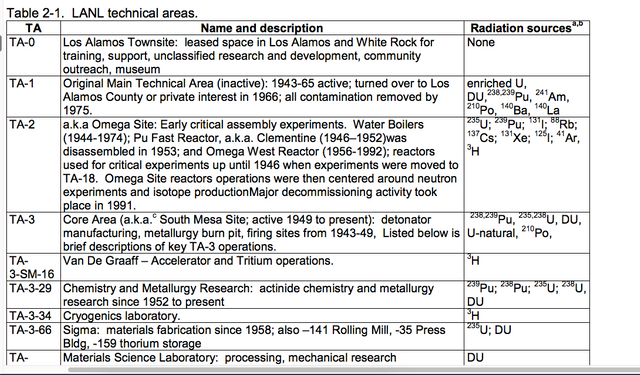
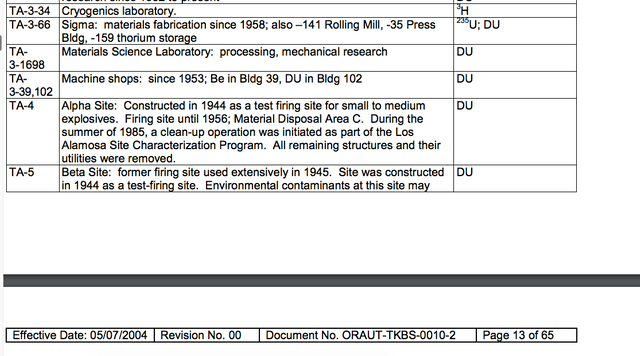
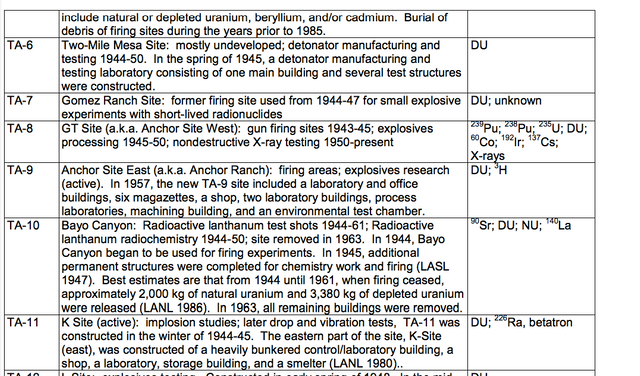
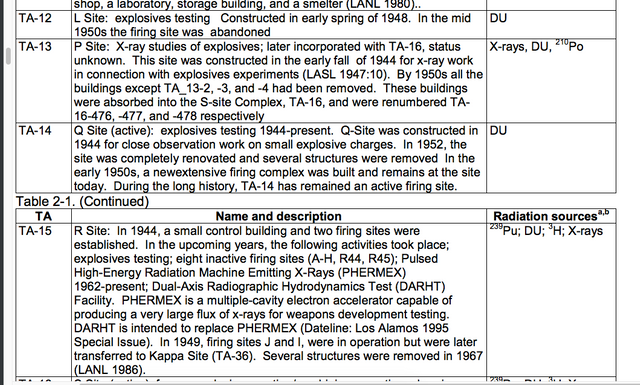
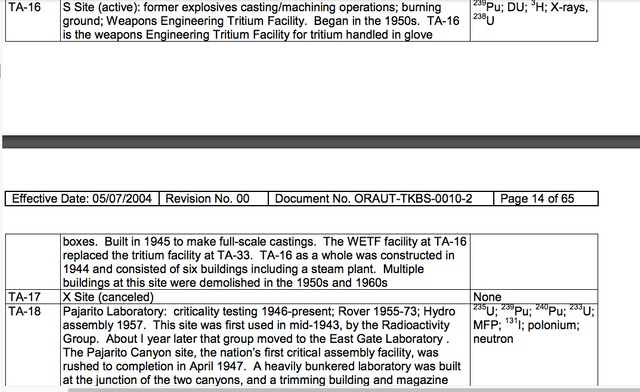
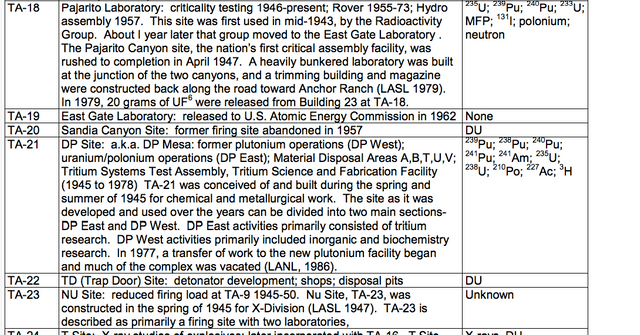
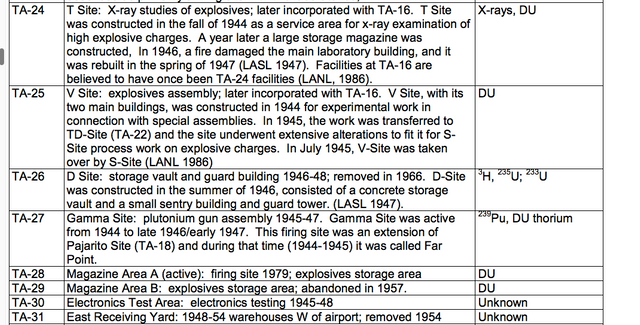
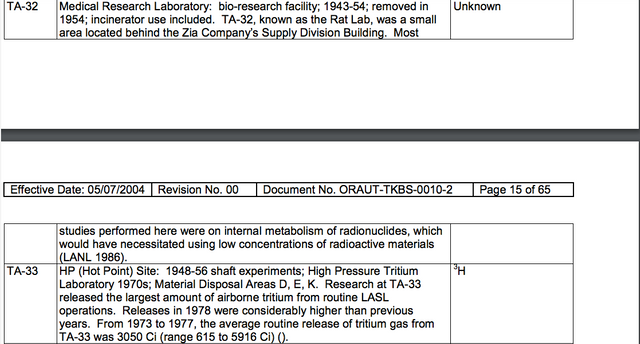
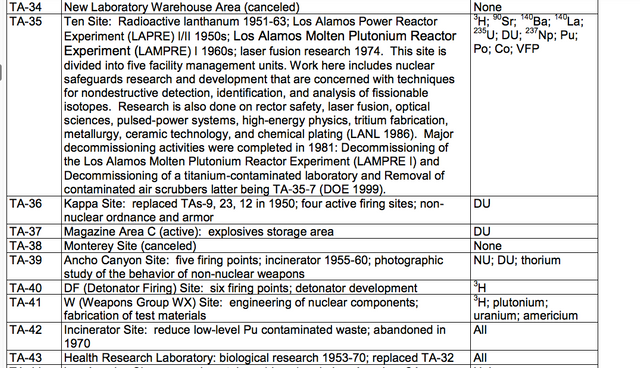
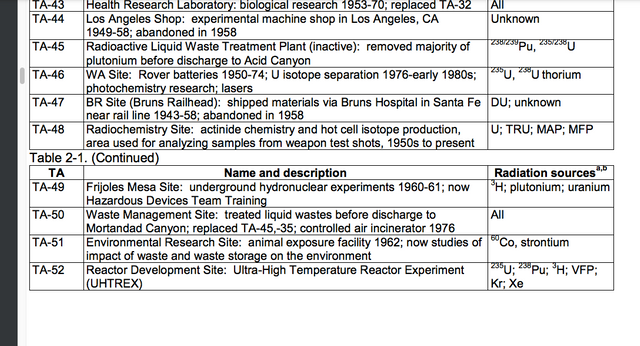
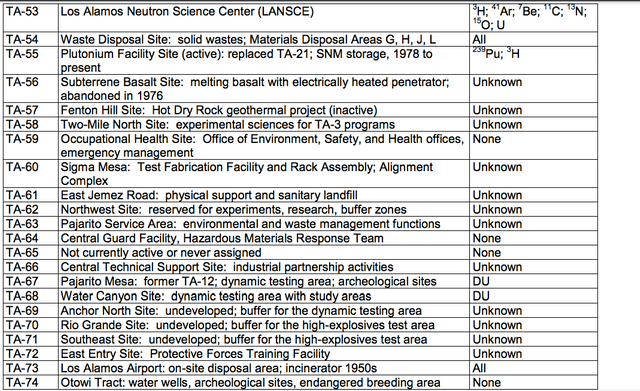

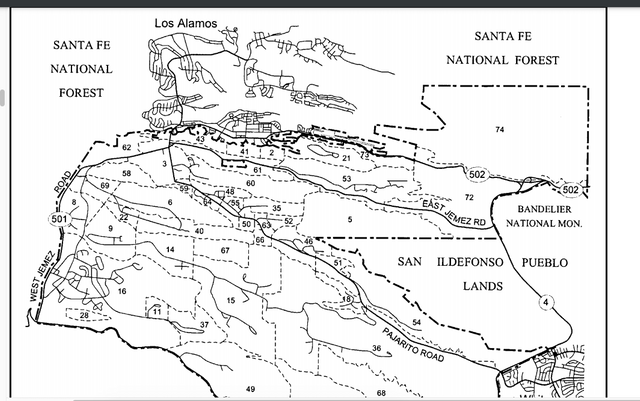
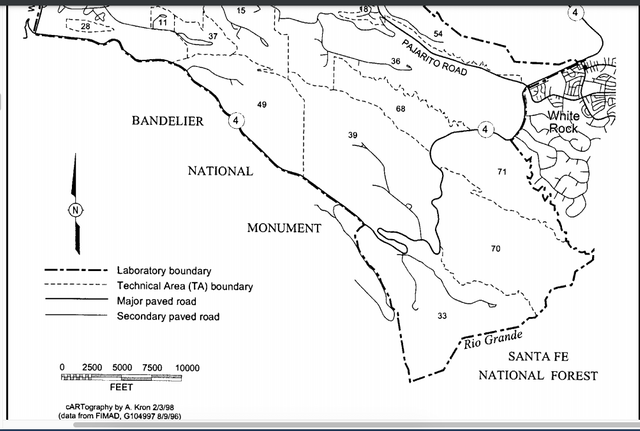
One of the important early roles of the Laboratory was the processing of the newly created element
known as plutonium. The assignments given to Los Alamos in the early 1940s were to:
Plutonium and Americium
• Perform the final purification of the plutonium received at Los Alamos
• Reduce the plutonium to its metallic state
• Determine the relevant physical and metallurgical properties
• Develop the necessary weapons component fabrication technologies
2.3.1.1 Early Plutonium Processing at TA-1
Los Alamos was the first site in the world to receive quantities of plutonium large enough to
manufacture weapons components. Plutonium processing was originally performed in TA-1 near utonium processing was originally performed in TA-1 near
Ashley Pond.
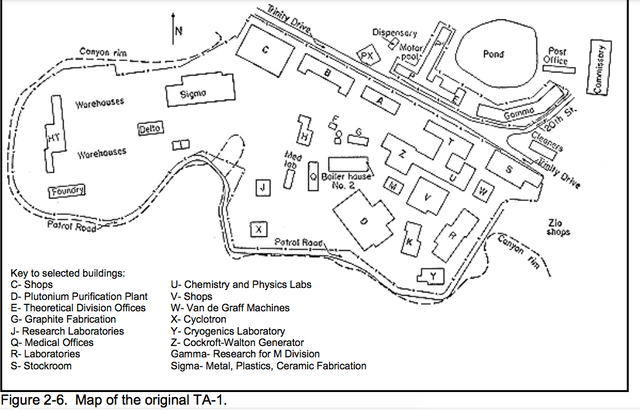
Evidence of Ether Extraction
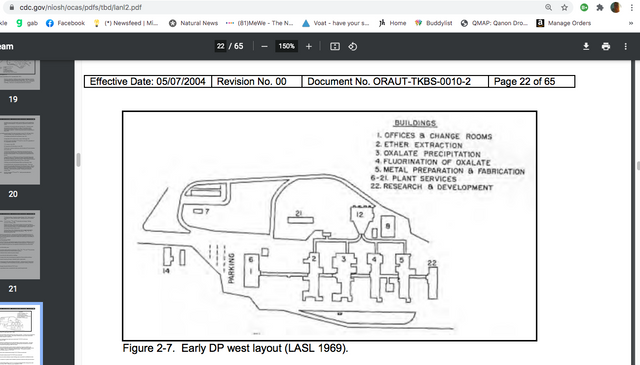
TA-33 The decommissioned Tritium lab
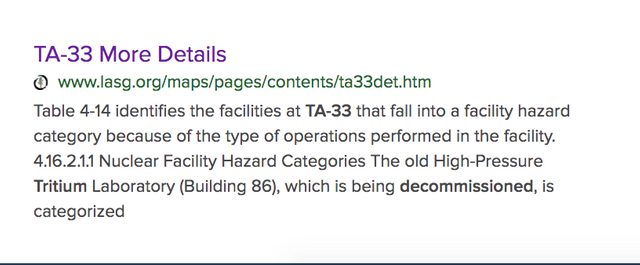
Tritium
A rare and radioactive isotope of hydrogen.The nucleus of tritium (sometimes called a triton) contains one proton and two neutrons, whereas the nucleus of the common isotope hydrogen-1 (protium) contains just one proton, and that of hydrogen-2 (deuterium) contains one proton and one neutron.
a colorless, odorless, flammable gas that combines chemically with oxygen to form water: the lightest of the known elements. Symbol: H
Tritium an isotope of hydrogen having an atomic weight of three. So 3H
Isotope every element (81 stable elements) has is own isotopic form.
An Isotope has the same number of Protons as it’s corresponding chemical element, but different number of Neutrons and different weight.
Isotopes of a single element possess almost identical properties.
Tritium is a gaseous, radioactive telltale byproduct of nuclear fusion. Its production all but confirms that fusion has taken place.
Also used in micro-electronic fabrication?
The Los Alamos National Laboratory (LANL) Tritium Systems Test Assembly (TSTA) project was begun in 1978 to develop, design, and demonstrate the technology and safe operation of selected tritium processing systems required for a fusion reactor. In 2001, the US Department of Energy (DOE) determined that TSTA’s mission was complete and that the facility should be stabilized.
At the completion of the stabilization project in 2003, TSTA was categorized as a radiological facility. Before stabilization was complete, the tritium inventory at TSTA was grouped in the following categories: tritium gas mixed with hydrogen isotopes, tritiated water absorbed on molecular sieve, tritium held up as a hydride on various metals, and tritium held up in process components.
Tritium is a radioactive hydrogen isotope that is found, both in natural and human-made forms, in water, soil and the atmosphere. It is generally only harmful when ingested in high doses in food and water, and it can increase the risk of cancer in some people, according to the Health Physics Society.
However, some medical research groups, such as the National Academy of Sciences, contend any amount of radiation exposure can risk damaging tissues, cells and DNA, potentially causing genetic mutations, birth defects and cancer.
Based on the variety and intensity of their experiments, the scientists said they believe that the tritium is real; it is not caused by contamination and it is not a product of normal electrolysis.
Bockris, a distinguished professor of chemistry, believes the announced findings of the two government labs will further silence cold fusion critics.
"What happens in the United States, being a pluralistic society, there are always many people for and many people against," he said. "I think a number of people against have just flipped over and become for.
Nonetheless, Bockris said Storms has told him that he and Talcott have been given $331,000 to continue their cold-fusion research at Los Alamos.
According to Bockris, the lab, run by the University of California and funded by the federal government, is in some sense is the most authoritative in the country because it's the national tritium center."
"What this (the funding) means is that as far as the Los Alamos National Laboratory is concerned, the bosses there - the people who control the funding - have decided that the thing is real. And they are going in for it," Bockris said.
According to an Executive Report on the Accelerated Production of Tritium
An assured supply of tritium is essential for maintatilng the current U.S. nuclear
weapons stockpile. Since tritium decays at a rate of 5.5 percent per year, the United
States must replenish the tritium supply through production.
The existing U.S. tritium production facilities are reaching the end of their useful life.
All production reactors are currently shut down. Additional environmental safety concerns
for these aging production reactors and processing facilities could seriously endanger adequate tritium supplies in the near future. New production facilities must be constructed
and become operational within the next 10 to 15 years, perhaps even sooner.
To supply tritium for the weapons stockpile, the Department of Energy (DOE) in
August 1988 recommended that the nation build new production reactors (NPRs) to replace the aging facilities at the Savannah River Plant (SRP).
Interesting as ether is what Keely worked on and the "powers that be" tried to cripple him.
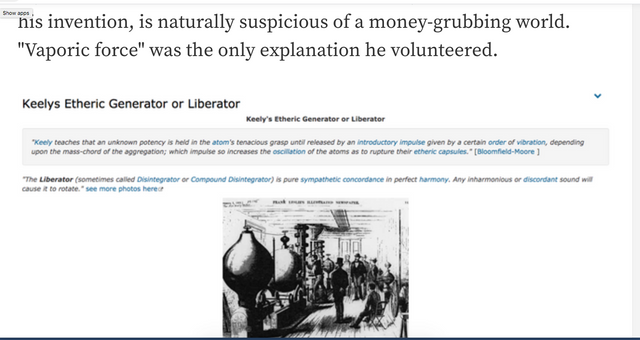
He secured substantial investments from many people, among whom was John Jacob Astor IV.
Keely announced that he had discovered a principle for power production based on the musical vibrations of tuning forks and that music could resonate with atoms or with the ether. Public interest was aroused and within a few months the Keely Motor Company was formed in New York, with a capital of $5,000,000, equivalent to $95 million in 2013.
See more in sources below.
Some of the first steps towards producing controlled nuclear fusion were taken at LANL. The AEC
called the project Sherwood. The project started at LANL in 1951, and expanded beyond Los Alamos
to become a nationwide effort. In 1952, six men and $50,000 were assigned to a laboratory trial of
the theories concerning the isotopes of hydrogen. Experiments began in a corner of the old U
Building at TA-1 with the heavy core of an abandoned betatron machine as the heart of what was
dubbed the Perhapsatron, because perhaps it would work and perhaps it would not. The
Perhapsatron was first operated in the fall of 1952, shortly after the Mike Test in the Pacific proved
that thermonuclear fusion was indeed possible. The Perhapsatron did not work, but it encouraged
further study in a new field of science, plasma physics. Huge electrical condensers were assembled
in the Project Sherwood Building. The unfulfilled promise of fusion led to the closing of the project by
the mid-1970s.
Fusion Research
The Perhapsatron used a toroidal Z-pinch, in which an induced toroidal current in the plasma
produced a self-magnetic field that pinched the plasma column. After the Perhapsatron came a
series of devices that used the pinch effect to seek the high temperatures needed for fusion. After the
doughnut–shaped torus of the Perhapsatron came linear pinch machines such as the Columbus
devices. Next, Scylla devices applied sudden compression on all sides through a strong magnetic
field. Scyllac was at TA-3 in Building SM-287. Scyllac was an 8-m-diameter controlled thermonuclear
reaction device. Los Alamos achieved the first controlled thermonuclear plasma in 1957 in the Scyllac
theta pinch device, which used a rapidly rising axial magnetic field to heat plasma through a
combination of shock and compression heating.
In 1958, physicist John Marshall developed a hydro-magnetic gun capable of shooting a plasma at
terrific velocities. This was a new method for use in testing theories of plasma heating and
confinement. The Pu Gun reported (in 1981) to be at TA-35 could have been this device.
Construction on laser laboratories for fusion research began at TA-35 in 1974. The HELIOS and
ANTARES are laser facilities for inertial confinement fusion research. HELIOS is a 10-kJ CO2 laser
fusion system with a10- μm wavelength, and ANTARES is a 40-kJ 24-beam CO2 laser fusion driver.
ANTARES was completed in December 1983.
The plasma thermocouple program involved research into methods for converting nuclear fission
energy directly into electrical power. This idea was born around 1942, and direct conversion was first
achieved by LANL physicists in 1958. N Division was created at LANL in 1955 to study potential
methods of nuclear propulsion in space. The group centered their efforts on Project Rover, in which
the LANL Kiwi reactors were developed, and ion or plasma propulsion for the far reaches of space.
Direct conversion was the first choice as power source for plasma propulsion.
As of 1963, there were more than 50 people working on the plasma thermocouple problem. The
method involved the principle of conventional two-metal thermocouples that produce small amounts of
electricity when one junction is hotter than the other. Scientists substituted an easily ionized gas for
one of the metals. When they electrically heated the metal emitter of the plasma thermocouple,
cooled the container around it, and introduced plasma or ionized gas such as cesium, a stream of
electrons flowed to the outside wall where they were collected. Later models used the energy of
nuclear fission to provide the heat. The goal of the program was to provide a power supply package
for space application with no moving parts or heavy turbines or generators.
The Health Division at LANL was responsible for monitoring worker health and instances of
overexposure to chemicals, explosives, and radionuclides in the workplace. The primary function of
the Health Group (A-6) was to establish safe tolerance levels, develop monitoring methods, and to
ensure that tolerance levels were not exceeded. Routine monitoring procedures were turned over to
the specific group concerned whenever possible. In 1943 the Health Group consisted of 10 people.
On June 1, 1947 the Health Group became the Health Division. In 1949, there were 97 members of
H- Division, and in 1951, there were 158. The Health Research Laboratory at TA-43 was built next to
the Los Alamos Medical Center from 1952 to 1954. Research performed at this site included
structural, molecular, and cellular radiobiology, biophysics, mammalian radiobiology, mammalian
metabolism, biochemistry, and genetics.
Health Division
The Health Group (later Division) produced over 150 Progress Reports. The reports were produced
on a monthly basis;-the oldest is dated November 1943, and the most recent report was published in
October 1960. The original policy of the Health Group was to depend entirely on information from
health research groups elsewhere. Because that policy did not always provide the proper data in time
to establish safe operating procedures, research projects were set up within the Health Group. The
monthly reports describe various areas of research and papers published on the health effects of
radiation and instrument development work conducted by the electronic and biophysics sections of
Radiologic Safety (H-1).
In 1943, the hazards of the project were reported to be limited to external radiation from the cyclotron,
the Van de Graff, the D-D source, and the radium sources. There were also hazards due to uranium
and the usual chemical laboratory hazards, but these were not considered serious. Only one accident
occurred during the first year that involved overexposure to radiation from the cyclotron.
In February 1944, plutonium arrived at LANL in significant quantities. The members of Chemistry and
Metallurgy Division and the Health Group became concerned about the dangers of working with this
material. Control of alpha-emitting materials worked out well for the first year, while a research
program developed tests for detecting overexposure of personnel to plutonium.
The initial external radiation hazard at LANL did not change until September 1944 when the Water
Boiler at Omega Site went into operation. When the power boiler went into operation in January
1945, there were several instances of overexposure when the exhaust line developed leaks. In
addition, there was an accident that resulted in serious exposures to several chemists during decontamination of the active material. There were two serious accidents that resulted from critical
assembly work, also at Omega: one that overexposed four individuals to gamma and neutron
radiation, and one fatality. During the radioactive barium and RaLa implosion tests that started in
September 1944, members of the chemistry group CM-4 received periodic overexposures to beta
radiation.
In the late 1940s and early 1950s, it was found that the natural soils and clays at TA-21 were effective
in removing radioactive contaminants from the waste liquids. Absorption beds were then used in
which the process effluent was emptied into a trench filled with absorption material consisting of
cobble, gravel, and fine sand. These beds were at Material Disposal Areas (MatDAs) T, U, and V
(see Table 2-5). By 1952, research had made sufficient progress toward reprocessing liquid waste. A
specially built waste treatment laboratory (TA-21-35) began reprocessing liquid wastes in 1952. In
1967, waste treatment operations were transferred to TA-21-257. Treated liquid wastes from both
Buildings 35 and 257 were occasionally discharged to the absorption beds at MatDA T until 1967.
From 1968 to 1976, wastes were mixed with cement and pumped down asphalt-coated shafts
augured between the two absorption beds at MatDA T. From 1975 to 1983, transuranic wastes were
mixed with cement and pumped into corrugated metal pipes, which were stored in the retrievable
storage pit dug between the two absorption beds at MatDA T. These wastes were retrieved from
1984 to 1986 and relocated to MatDA G at TA-54. One of the two 50,000-gal tanks was emptied, and
the second partially emptied, of their liquid plutonium-nitrate solution. The second tank contained
liquid awaiting upgrade of the 1979 waste treatment system because the nitrate content of the waste
was too high for the current system.
Solid wastes from TA-21 were, in general, either buried or incinerated.
On April 23, 1961, two workers from Group H-1 participated with the U.S. Geological Survey in a
project to seed Lake MacMillan near Carlsbad, New Mexico, with 3
H. This tracer study was designed
to determine the extent/size of the Lake McMillan underground reservoir. Water from the lake seeps
through the lakebed into underground waterways and comes to the surface again at various points
several miles downstream in the Pecos River. It has been estimated that this underground waterway
could be a vast lake more than 5 mi in diameter. Five containers of 3
H from ORNL, each holding 50
Ci of tritiated water, were transferred to the lake. Release of water from the lake was stopped on April
24 and gates were kept closed for 1 week. The amount of 3
H added was calculated so that resultant
concentrations would be less than 1/500th of the level generally and officially regarded as safe and
acceptable for drinking water. A concentration of less than 0.02 µCi gal-1 was expected in the lake,
with even more dilution once it reached the underground reservoir.
Special Studies
In 1983, LANL personnel participated in uranium mapping of the impact area from the DIRECT
COURSE event at White Sands Missile Range.
According to the environmental impact statement for LANL (DOE 1979), some workers received
radiation doses at levels higher than the general public.
Sources
https://www.wired.com/2003/02/nuke-lab-cant-keep-snoops-out/
https://www.globalsecurity.org/wmd/facility/los_alamos-facility-ta.htm
https://www.cdc.gov/niosh/ocas/pdfs/tbd/lanl2.pdf
https://www.osti.gov/servlets/purl/565666
https://www.armimilitari.it/wordpress/wp-content/uploads/2014/08/trijicon-acog-3x30.pdf
https://blog.gritrsports.com/trijicon-ta33-review/
https://permalink.lanl.gov/object/tr?what=info:lanl-repo/lareport/LA-UR-98-4463
History and timeline of Los Alamos and the laboratory
https://permalink.lanl.gov/object/tr?what=info:lanl-repo/lareport/LA-UR-98-4463
http://www.lasg.org/maps/pages/contents/33contents.htm
https://fas.org/sgp//othergov/doe/lanl/lib-www/la-pubs/00312197.pdf
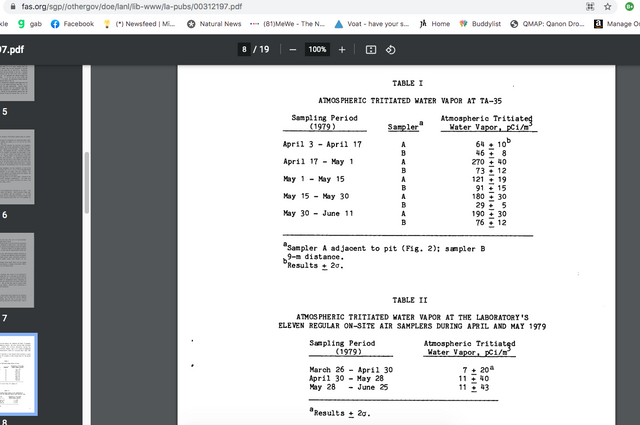
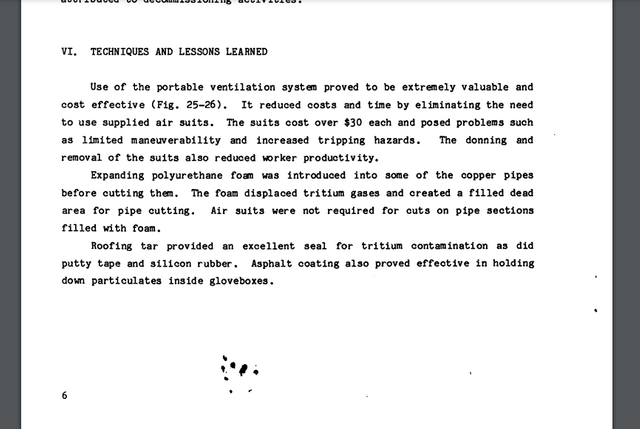
https://www.lanl.gov/about/history-innovation/index.php
https://www.washingtontimes.com/news/2020/sep/15/turab-lookman-los-alamos-national-lab-scientist-re/
https://www.theverge.com/2015/1/11/7529111/doom-of-los-alamos
https://www.lanl.gov/news-archive/news-releases/2010/March/03.10-directors-colloquium.php
https://www.lanl.gov/org/ddste/aldps/physics/subatomic-physics/henp-team.php
https://www.lanl.gov/org/ddste/aldps/physics/subatomic-physics/index.php
https://fas.org/sgp/othergov/doe/lanl/index1.html
Collider probes of real triplet scalar dark matter
https://link.springer.com/article/10.1007/JHEP01(2021)198
https://brewminate.com/a-brief-history-of-hacking-from-the-1960s-to-1990s/
https://www.energy.gov/articles/teslas-lab-los-alamos-powerful-magnets-come-full-circle

https://quantum.lanl.gov/q_computing.shtml
Dateline Los Alamos
https://fas.org/sgp/othergov/doe/lanl/docs1/00285672.pdf
https://hwbdocuments.env.nm.gov/Los%20Alamos%20National%20Labs/TA%2033/4706.pdf
Tritium Monitor Calibration at Los Alamos National Laboratory
https://digital.library.unt.edu/ark:/67531/metadc699233/m2/1/high_res_d/634020.pdf
Accelerator Production of Tritium
https://fas.org/sgp/othergov/doe/lanl/lib-www/la-pubs/00186851.pdf
From Oct. 2020
Area residents expressed concerns this week about the potential health hazards of releasing radioactive vapors into the atmosphere from four barrels of tritium-laced waste stored at Los Alamos National Laboratory.
Most who spoke during a virtual forum Tuesday hosted by the National Nuclear Security Administration complained the Los Alamos lab had not discussed its plans with the public about venting the tritium waste containers and wasn’t fully considering the public health risks.
“There needs to be a greater analysis of the potential health and environmental effects of releasing radioactive tritium into the atmosphere,” said Virginia Necochea, executive director of the New Mexico Environmental Law Center. “We know tritium is very dangerous when inhaled. There’s no safe level of tritium exposure.”
Tritium is a radioactive hydrogen isotope that is found, both in natural and human-made forms, in water, soil and the atmosphere. It is generally only harmful when ingested in high doses in food and water, and it can increase the risk of cancer in some people, according to the Health Physics Society.
However, some medical research groups, such as the National Academy of Sciences, contend any amount of radiation exposure can risk damaging tissues, cells and DNA, potentially causing genetic mutations, birth defects and cancer.
“We’re tired — we don’t want it,” said Carol Miller, who added she spent 50 years in public health. “You create these dangerous situations, and the solutions are about as dangerous as what was created.”
https://www.sbir.gov/sbirsearch/detail/138277
https://fas.org/sgp//othergov/doe/lanl/lib-www/la-pubs/00318116.pdf
https://nukewatch.org/nuclear-weapons-complex-maps/active-map/los-alamos-national-lab/
https://fusionenergy.lanl.gov/
https://data.nbmg.unr.edu/public/Geothermal/GreyLiterature/Goff_MagmaticTritium_1997.pdf
https://srnl.doe.gov/facilities/htrl.htm
Los Alamos Historical Docu Retrieval and Assessment Project LAHDRA
https://wwwn.cdc.gov/LAHDRA/Content/pubs/reports/sections/Cover%20thru%20Chap%202.pdf
SEC Special Exposure Cohort
Los Alamos National Laboratory LAHDRA / Internet - DOE OpenNet H Division progress reports 1947-1955. 12/20/2006 6 Los Alamos National Laboratory / SC&A Final site-wide environmental impact statement for the continued operation of LANL. 08/06/2004 1 Lovelace Respiratory Research Institute General information on the LANL bioassay program.
https://www.cdc.gov/niosh/ocas/pdfs/sec/lanl/lanler-109-r1-a.pdf
https://features.propublica.org/los-alamos/chad-walde-nuclear-facility-radiation-cancer/
https://www.savannahrivernuclearsolutions.com/docs/srns_today_0819.pdf
https://www.nukewatch.org/SNL/index.html
https://fas.org/sgp//othergov/doe/lanl/lib-www/la-pubs/00310697.pdf
https://www.ucsusa.org/resources/us-nuclear-weapons-complex
https://srnl.doe.gov/about/nat_security-defense.htm
https://www.sandia.gov/news/publications/lab_accomplishments/articles/2017/Pulsed%20Power.html
http://archive.wmsym.org/2012/papers/12301.pdf
Silent Running